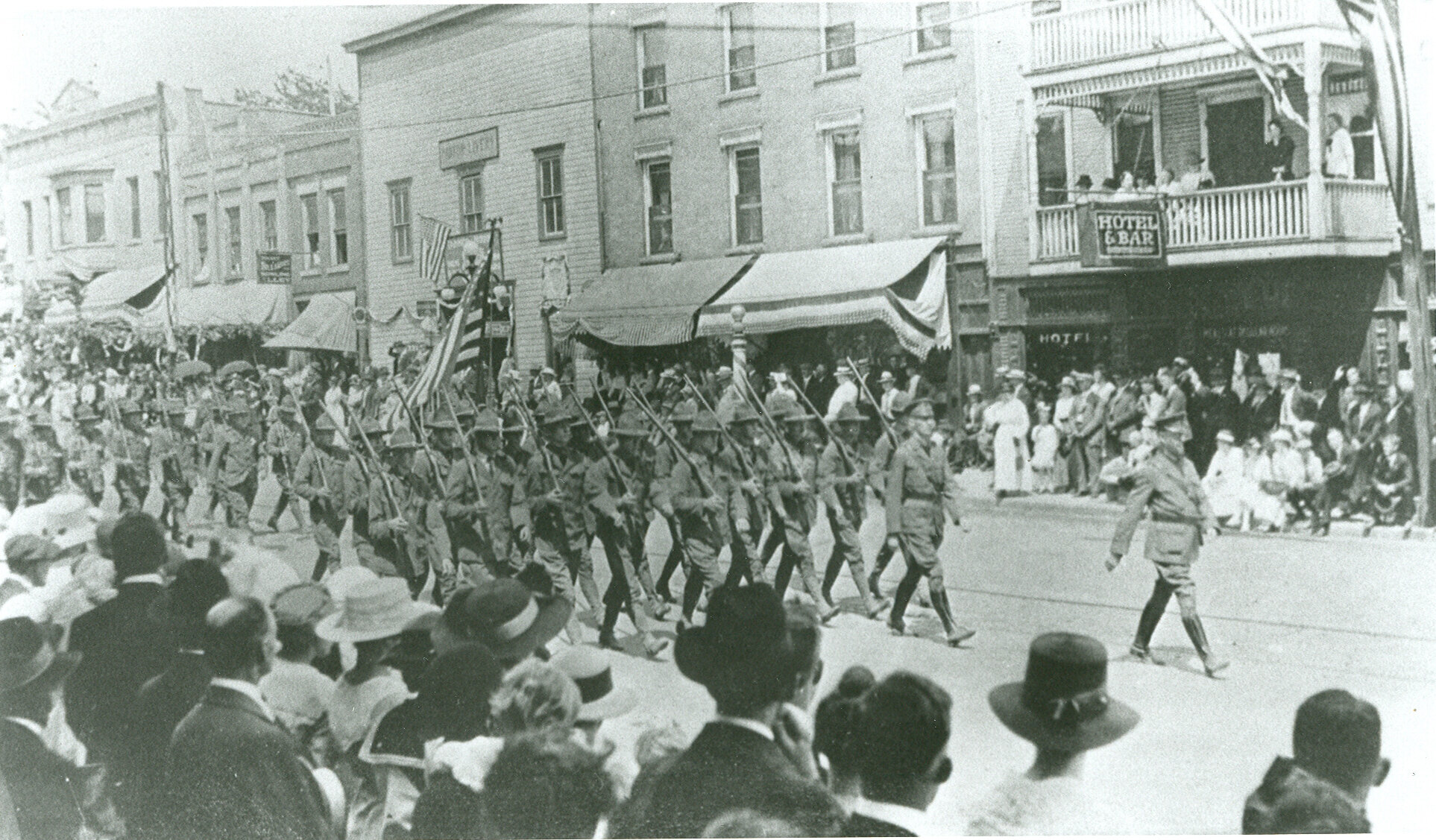By Lindsay Judd, Executive Director
Over 100 years ago, the world lost approximately 6% of its total population. Over 100 million individuals perished over the course of one year.
What happened? Why did so many die? Why were the effects of this pandemic so pronounced? The people affected by the outbreak went to parades. They answered the draft. They aided those in need. They breathed unprotected in public. The 1918 Influenza, the “Spanish Flu,” remains to this day one of the deadliest natural disasters in human history.
January 1918 saw the beginning of the influenza epidemic. At that point, the strain of influenza infected children, people who were already sick, and the elderly. It behaved like a normal flu and had the same typical symptoms we experience during the common flu today. The United States had been at war for just over one month.
World War I Soldiers marching on Main Street in St. Charles.
Hospital workers at the old St. Charles City Hospital, c. 1912
Because the symptoms were typical of the flu at that time, no one panicked—yet. In April 1918, as the flu began to affect more people, there was criticism that there had not been enough preventative measures taken to combat the virus.
In addition to children, the sick, and the elderly; soldiers were the main group of people who became infected. The reason for this was that the living conditions for soldiers were ideal breeding grounds for this strain of virus. Close quarters, massive troop migrations, immune systems weakened by malnourishment, and the stresses of combat and chemical attacks caused soldiers to be highly susceptible to influenza. Their movement across the ocean was a leading factor to the alarming rate at which the disease spread. There was a lull in the virus during the summer of 1918. But as soldiers made their way to the battlefront, many of them brought contagion with them and awakened the outbreak in Europe.
By August, as the virus spread, it mutated and day by day it grew more deadly, but the public was not aware of it yet. A headline from the St. Charles Chronicle dated August 29, 1918 proclaimed, “QUARANTINE OFF; SCHOOLS WILL OPEN.” It was at this point that the virus began its second and deadliest wave.
St. Charles Chronicle Headline announcing the end of preventative quarantine measures in August of 1918, just weeks before a second deadly wave swept across the country.
In addition to the normal flu symptoms, this strain restricted people to bed as if they had been hit by a bus. It often turned into pneumonia, which turned people’s skin black and blue. Lungs would fill with fluid and people would essentially drown from their own body. There were reports of people in their twenties whose fevers were so high, their hair turned white and fell out. The aggressive second wave of influenza attacked not the elderly or children, but healthy young adults. People of ages 21 to 29 were the most affected.
Because soldiers were the main group of people who were afflicted, regular civilians felt a false sense of security as they thought, “That won’t happen to us, that’s a soldier's disease.” But then it did happen to “us.”
As the war raged on, Britain, France, Germany, and the United States censored early reports of influenza and mortality to maintain wartime morale. Spain was not involved in WWI, so they did not censor their papers and were the first to widely report on the outbreak. When they reported that Spain’s King Alfonzo VIII was gravely ill with influenza, it gave the world a false impression that the virus originated in Spain, thus leading to the name “Spanish Flu”, despite the fact that the exact origin of the virus remains unknown.
The war efforts were one of the major causes of contagion. In September 1918, 13 million men were drafted for the war. Men flocked to schoolhouses, city halls, and post offices to answer the call. Where the U.S. Health Department wanted to shut everything down, the war effort needed everything to speed up. Factories needed to keep operating, civilians needed to continue having loan drives, soldiers needed to continue being shipped to Europe. Despite the Health Department insisting on shutting down public gatherings, the country was in tunnel vision and focused solely on the war. At that time, the war was seen as a more important issue.
Soldiers in treatment at a temporary medical facility at Fort Riley, Kansas. This photo is often used as one of the most famous illustrations of the size and scope of the flu outbreak Americans were up against in 1918. Otis Historical Archives, National Museum of Health and Medicine
Some officials in big cities refused to acknowledge the threat insisting there was nothing to worry about and that the virus would naturally take its course without intervention. At a Liberty Loan parade in Philadelphia, civilians linked arms and sang patriotic songs, all the while spreading the virus from one individual to the next. In the days that followed, the influenza ripped through Philly, spreading exponentially.
The influenza was so vicious that patients would see the doctor about minor symptoms, and within twelve hours they would fall victim to the disease. The strain spread fast and killed quickly. In September alone, 12,000 Americans died from influenza.
Nurses were needed as desperately on the home front as they were in Europe. The nurses who remained in the States were some of the most fearless people in American history. Despite the likelihood of themselves contracting the virus, they took care of the sick to the best of their abilities. Alongside soldiers, nurses were another group of people who were heavily affected.
It was insisted upon that all public gatherings be banned and all public places like, schools, churches and stores be shut down to help prevent the spread of the virus. If an establishment failed to close despite the warnings, they were listed in the newspaper and forcibly shut down by the Health Department. Theaters were one of the most common offenders, in that many refused to shut down for fear of losing money, yet the atmosphere of a theater was ideal for the virus to spread.
At this point in history, science and medicine had progressed enough to where they had vaccines for diseases like smallpox, anthrax, rabies, diphtheria, and meningitis. Because of these advancements, people felt a sense of invincibility, and therefore did not heed the precautions that the U.S. Health Department advised, which exacerbated things.
Despite the monetary investment in the war, the United States government gave the Health Department one million dollars to help fight the flu. Biochemists developed a potential vaccine to combat the influenza. However, the vaccine they created was meant to fight bacteria, not viruses. Since influenza was a virus, the vaccine was useless. Very little was known about viruses at this time, and because microscope technology was not advanced enough, they could not physically see the virus microbe to study it in-depth.
When October came, it became apparent that seemingly nothing was available to fight and stop the influenza. There was a nightmarish paranoia and hysteria that gripped people everywhere. Where was safe? Who was safe? People were living in fear of each other. It drove some people mad to the point of suicide. People honestly believed that the end of the world had arrived.
Hospitals overflowed with patients. Many public spaces like schools, parks, and playgrounds became emergency relief centers. Some people attempted concocting their own medicines, which did nothing except prove even more harmful.
In some large cities, horse-drawn carts were sent around to collect bodies from homes, and mass graves were dug because there was a coffin shortage. In October 1918 alone, in just thirty-one days, 195,000 Americans died from influenza. It remains the deadliest month in American history.
By early November, as the war came to an end, there was a sudden drop in influenza cases. Out of nowhere, the death toll began to decline. It was generally accepted that the virus died out because it ran out of susceptible victims. People celebrated both the war’s end and the finale of the epidemic.
Oddly enough, St. Charles did not see many cases, possibly because it was still a “rural” town and wasn’t heavily populated. By the end of October, St. Charles saw ten deaths from influenza. There hadn’t been any deaths recorded for weeks prior to October 9, 1918.
By mid-October, the St. Charles School for Boys was ravaged by influenza. There was a total of 250 cases, and seven boys ranging from ages 12-17 died over the course of 15 days. Dr. Kristin Johnson was the attending physician at the school on October 29th, and three out of seven boys died in a single day. Six more boys died between November 4-14, all aged between 14 and 16.
The St. Charles School for Boys was a local “hotspot” for flu transmission during the 1918 pandemic.
St. Charles saw two more deaths in December, two in January of 1919, and one death in April 1919.
By December 4, 1918, 350,000 Americans had died since September 15. In ten months, 600,000 Americans died. To this day, scientists, medical scholars, and historians still do not know what exactly caused the virus, or why it died out so suddenly.
102 years later, we are faced with another pandemic: COVID-19. The seriousness of these two viruses are the same, but the difference this time around is that we have learned from history. We can look back on the Spanish Flu pandemic and determine what worked and what did not.
We know for certain that allowing large crowds to gather and holding public gatherings aggressively contributed to the spread of the disease. We know that downplaying the situation to maintain morale did not work. And finally, we know that unity; working together; building each other up and lending support to those in need: that is what works to fight an aggressive and mysterious virus.
These lessons, combined with significant advancements in medical technology and vaccines, give us continued hope as we continue to work together through tough and uncertain times with the intention of returning to our normal lives as soon as it is safely possible.









